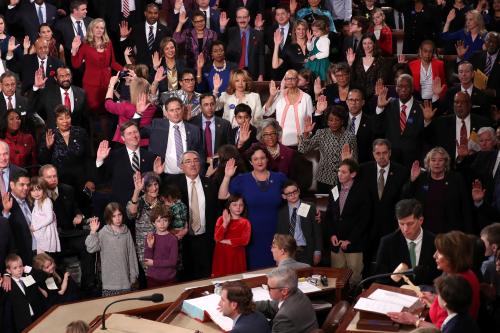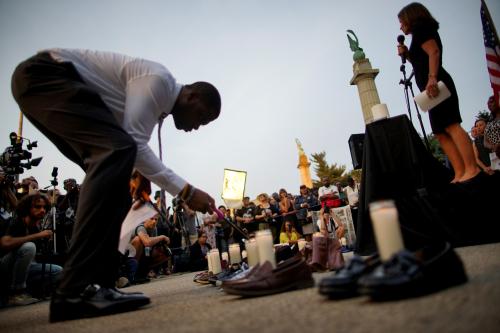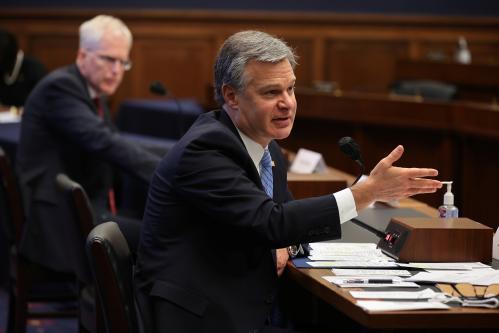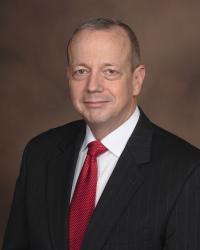On January 15, 2020, Brookings President John R. Allen, along with Paul Goldenberg, Co-Chair, Homeland Security Advisory Council Subcommittee for the Prevention of Targeted Violence Against Faith-Based Organizations, testified before the Subcommittee on Intelligence and Counterterrorism of the House Committee on Homeland Security on the rise in anti-Semitic domestic terrorism.
JOHN R. ALLEN: Chairman Rose, ranking member Walker, and members of the subcommittee – good afternoon. As noted, my name is General John Allen, and it is a great pleasure to be here before you this afternoon, and to be joined by Paul Goldenberg, my fellow co-chair of the Homeland Security Advisory Council Subcommittee on the Prevention of Targeted Violence Against Faith-based Communities. We are exceptionally grateful for your continued leadership on the issue before us today – that of anti-Semitic violence, to include the threat of domestic terrorism – and are doubly appreciative of your support of our recently released Homeland Security Advisory Council report. In this critical moment, your leadership shines through – thank you.
Paul and I will be giving a joint statement this morning and thus will speak to different portions of our testimony over the next ten minutes. We request this statement be entered into the record and afterward look forward to answering your questions. With that, let me turn it over to Paul for a recap of our mission with the Council, as well as our assessment of the current threat facing faith-based communities today.
PAUL GOLDENBERG: Good afternoon, ladies and gentlemen. Let me mirror General Allen’s thanks – we’re here today because of your leadership. You would be hard pressed to find a more pressing topic, and it our privilege to speak to you all today, and to bring to life the very real threat facing our faith-based communities, including those of an anti-Semitic nature.
To recap, our mission with the Homeland Security Advisory Council began on May 20th of last year, when then-Acting Secretary Kevin McAleenan tasked us with examining, considering recent attacks against synagogues, churches, temples and mosques, the security of faith-based organizations across the country.
The Subcommittee we had the honor of co-chairing was tasked to “provide findings and recommendations on how DHS can best support state and local governments’ and faith-based organizations’ efforts to keep houses of worship safe, secure, and resilient.”
Our final report – which was released almost exactly a month ago on December 17 – followed the tasking letter of then-Acting Secretary McAleenan, who requested we examine three areas or taskings:
Tasking One – Ensuring two-way information flows between DHS and faith-based organizations.
Tasking Two – Evaluating preparedness and protective efforts for the faith community.
Tasking Three – Evaluating the role the faith-community could/should have in locally-based prevention efforts.
A fourth tasking was also added by the then-Acting Secretary following a public hearing in Jackson, MS, Chaired by Congressman Bennie Thompson, Chair of the House Committee on Homeland Security.
Congressman, it’s great to see you again today.
Thus, Tasking Four came to be, which reads – Evaluate the adverse impacts that violent extremists and domestic terrorists, including those inspired by violent white supremacy ideologies, have on faith-based and other vulnerable communities.
Our work was significantly aided by the advice and counsel of at least 20 SMEs and witnesses, representing offices and entities from across DHS and the broader USG, including DOJ, FBI, USSS. As alluded to earlier, and I believe notable, is that our members also took to the field visiting Synagogues, Mosques, Temples and Churches, meeting with communities impacted by targeted violent attacks committed by violent extremists.
These engagements were eye-opening, and as someone who has proudly served as a member of the law enforcement community – I have personally come to recognize that our nations faith-based communities are one of the few institutions that has the resources, the will – to bring together all age groups, people of contrasting political opinions, races, religions, who can unite communities from a variety of backgrounds and interests, offering a range of competencies not often found in a single community organization, police force or government agency. They have the fundamentals to empower people, developing a sense of ownership among our whole community.
Nonetheless, and most unfortunately, we’re here today because a growing number of bad actors have opted to set their sights on the very soul of America – our communities of faith.
Today – throughout Europe, countless houses of worship are surrounded by crack military troops standing guard with automatic weapons, reinforced by heavy armored personal carriers, guard towers augment the once stately and welcoming entryways, flower beds swapped for barbed wire; at a cost of hundreds of millions of Euros producing a dreadful impact on the psyche of Europe’s people.
For Europe has become — America’s canary in a mine…
The question of whether the Faith Based community – and certainly the Jewish community – is targeted by hatred and terror is not up for debate. Houses of Worship, here and abroad remain targets. In this country, both law enforcement and communities of faith recognize this unique reality and are pursuing proactive steps to link the mission of the Department of Homeland Security and the Nation’s million-plus first responders, with the concerns of faith-based institutions.
To the threat itself, the primary inspiration behind many of these targeted violent attacks is to force us to not merely question our fundamental safety and security, as well as our ability to protect our nation, neighborhoods and families, but to change our behaviors.
It is with this in mind that we are talking about this in a domestic terrorism context.
Indeed, success in the eyes of domestic violent extremists and international terrorists comes when we retract from our daily routines, ways of living and even spiritual and political beliefs. One underestimates the power of fear at his or her own risk. The effects of extremist manifestos, threats, and plans for violent actions are now routinely shared on social media sites such as 4chan, 8chan, and these efforts are strategically calculated on the part of these bad actors and can have a long-lasting and deeply destructive effect on our communities.
We have come to learn that the goal of violent extremists is often not just to cause loss of life—nevertheless, more perilously, it’s to wear us down, psychologically, emotionally and spiritually, causing our endurance, determination and morale to decay and ultimately disappear. That dynamic was readily apparent across the communities we engaged with, regardless of whether they had personally experienced targeted violence or threats.
As attacks perpetrated from white violent supremacist actors and other similar separatist and violent extremist groups grow in number – and they have been growing at an alarming rate – we should be concerned that an adverse public reaction may generate something that these violent extremists could never have achieved on their own.
This complex psychological progression becomes an enabling tool for those who seek to derail our way of life. Citizens immunized against the psychological influence of targeted violence and terrorism have a greater ability to resist such manipulation – we cannot allow this to happen.
If violent extremists believe that their assault on our communities of faith is not likely to create mass chaos and fear and a subsequent unraveling of the values of our people to an extent that it damages the bond between a government and its citizens, they may have less reason to waste their resources on such an attack. If our faith communities and workforce are provided resiliency and preparedness training and are convinced the measures we will take in preparation will increase the odds of survival and successfully coping with a catastrophic event, we are then more likely to internalize personal preparedness as necessity rather than commodity.
That was our perspective, and our mission, within HSAC. Let me now turn it back to General Allen to discuss our recommendations – the tone of which I just previewed – for responding to this threat.
JOHN R. ALLEN: Thank you, Paul. Ladies and gentlemen of the subcommittee – what Paul just described is no ordinary threat. It’s a national security issue for the United States, and a threat to our way of life. That’s the truth, plain and simple, and it cannot be overstated.
Nevertheless, we’re not here today to simply admire the problem – we’re here to discuss what we can do about it. To that end, and much of this is reflected almost verbatim in our recent report, we need to be thinking about these issues within a strategic – as well as a tactical – framing. Or, rather, there are efforts that can be undertaken at the national level – with Congress and the Administration leading the charge – and there are efforts best handled by our local communities.
Our report contains 46 recommendations overall, but we lay out seven key recommendations in response to the unique nature of this issue, and we’re happy to go into greater detail on those specifics during Q&A.
To add a bit of personal framing however, the way I’ve described much of this – and some of this comes from my prior service in the U.S. Marine Corps – is the left, right, and center of “bang,” with the “bang” being a violent event, which here we’ll call “the incident”.
Measures to the left of the incident are what we’d describe as preventative measures. Here, consistent training and community outreach are key, especially between State and local law enforcement and our faith-based communities.
At and during the incident itself – these are protective measures, which can range from the deployment of Protective Security Advisors to increased coordination with first responders and, of course, increased defensive capabilities for the communities themselves. In this category, funding – especially through the FEMA Nonprofit Security Grant Program – is crucial, particularly in the context of buying those precious moments before law enforcement is able to arrive on site and intervene. And let me pause to thank you, the Congress, for putting more funding behind this truly essential program.
Finally, right of the incident. This can include anything from resiliency efforts within the community, to efforts focused on healing and reconciliation, as well as justice and accountability. It’s the response – with social workers and community advocates playing as much a role as law enforcement and legislators.
It’s that last point – the role of legislators – that I’ll focus on, however. For you, the Congress, this means three things, in my mind. This is as much a personal recommendation as it is framing from our time as co-chairs with HSAC.
First, in many respects, during this very difficult time in our history, the Congress may be our last best hope to address these urgent matters, and your being seized with this matter, ladies and gentlemen, is essential to the preservation of the social fabric of the American society. Thus, your leadership, as exhibited today, is crucial. Increasing violence against our faith communities is an emergency and deserves to be treated as one. This issue needs greater attention, and Congress is best situated to keep it in the public eye. I’ll leave it at that – it could not be more important.
Second, Congress of course has the power of the purse. In addition to what was described in the report recommendations, our faith-based communities need more resources to invest in a wide variety of preventative and protective measures and capabilities. This can come in the form of the grants I mentioned. Quite simply, our faith-based communities need to be better resourced and these grants are the best way of realizing a solution. Separately, but related, our nation’s law enforcement and first responders are stretched thin. They’re doing what they can, in supporting both preventive and protectives measures for our faith communities but are also badly in need of additional resources.
Finally – our laws. The deterrent and protective nature of increased legal clarification and accountability surrounding the domestic terror threat, and those who pursue such acts, cannot be overstated. We did not in our report delve into a specific law – namely, a domestic terror law, or a domestic terror designation for individuals or groups – but I believe the time has come for a very serious debate on this measure, and it’s something worth discussing. We do discuss the need for defining domestic terrorism in our report, at the very least within the DHS and DOJ. That’s essential. DHS’s new Strategic Framework undertakes a good start on this, but we must see this through.
PAUL GOLDENBERG: Thank you, General.
As the list of recent attacks against American faith-based communities grows, we have seen a rekindled call for domestic terrorism laws to provide federal law enforcement agencies similar tools that are available to combat targeted violent attacks committed by international terrorists. In the late 1980s I was appointed the nation’s first chief of a State Attorneys General Office dedicated to the investigation and prosecution of hate crime and ethnic terrorism.
Back when we had scarce laws on the books addressing these issues, it was quite challenging for my detectives when deployed to Synagogues, Churches and Asian Indian Temples across the state experiencing attacks against their institutions, intimidation, desecration of cemeteries, assaults, these horrific criminal acts terrorized whole communities – however, they were hard to prosecute as serious offences as we had no laws codifying a hate crime as a felony act, thus making resources, training and requests for additional personnel quite challenging. It was extremely difficult to travel to these communities and explain to them why these offenders were not in jail.
Many believe that these bills – domestic terror laws, specifically – would provide required resources to federal law enforcement officials, some of whom have indicated that they do not possess suitable tools for addressing domestic terrorism. In some hate crime cases prosecutors have had to seek out several federal statutes to use against those who have engaged in apparent domestic terrorist activities. Others have indicated that laws already on the books are adequate to address targeted violence against religious institutions that come to mind when discussing domestic terrorism — the real challenge for law enforcement is that these charges can be filed only after these violent extremists complete or attempt acts of violence.
Coming from state law enforcement I recognize that these state laws often include attempt and conspiracy provisions, however, local and state law enforcement agencies commonly lack the resources to conduct these complex and long-term investigations. I’m happy to speak more to this issue in Q&A.
But to close, faith-based and nongovernmental organizations extend far beyond faith, spiritual care, and health and human services; they are an important component of a collective and cooperative homeland security effort. Faith-based and nongovernmental organizations own and operate infrastructure that remains vulnerable to attack, provides direct support and response to our nation’s worst natural and manmade disasters, and provides vital services to tens of millions of Americans every day. These include vast networks of organizations and operations with facilities, capabilities and processes on a massive scale that need to be more integrated into our collective homeland security efforts.
During times of crisis and other homeland security events, it is neighborhood congregations, community outreach centers, social service agencies and other community organizations—the very fabric of America—that are best positioned to become critical partners in local and national homeland security initiatives. Every recommendation General Allen discussed, to include what is encompassed in our HSAC report, is sourced in that reality and framing.
These communities – America’s bedrock, if you will – can only do so much on their own. They simply need the resources and training to make it a reality. DHS – and really the entire USG – can offer them this, and we’ll be significantly safer as a result.
Finally, let me highlight that roughly halfway through our research, then-Acting Secretary McAleenan unveiled the Department’s Strategic Framework for Countering Terrorism and Targeted Violence. Drawing on this document, our recommendations were intended to advance the goals set forth in the Strategic Framework, namely, to “understand the evolving terrorism and targeted violence threat environment, and support partners in the homeland security enterprise through this specialized knowledge”; “prevent terrorism and targeted violence”; and “enhance U.S. infrastructure protections and community preparedness.”
This document also made it very clear that while there were still significant sources of foreign terrorism against which we must guard, the principal source of domestic terror has been and increasingly comes from violent white supremacist movements, and these movements are a direct threat to our American faith communities. This is incredibly important, and I’d be remiss in not highlighting how foundational this document can be, assuming it is internalized and acted upon. As well, Kevin McAleenan’s leadership on this issue was significant, and he should be commended for putting this document out in the public realm for debate and iteration.
Let me also say that in having had the honor and privilege of working with our current Acting Secretary Chad Wolf over the years, I could not possibly recount the number of times he has pushed on this issue. General Allen noted in his statement the importance of being seized with this moment, and this topic. That is certainly the case for Acting Secretary Wolf, and I can personally attest to his passion and care in fighting for progress in support of our Faith-based communities.
With that, we’ll close. General Allen and I welcome your comments and questions. Thank you for the opportunity to speak on this important issue.







Commentary
Op-edConfronting the rise in Anti-Semitic domestic terrorism
January 15, 2020